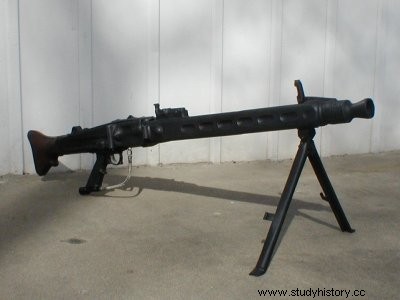
Locking:by rollers
Operation:by short recoil of the barrel (direct action of the gas stream)
Ammunition:7.92mm x57 (7.92mm Mauser)
Feeding:50 and 250 round strips.
Total length:1219 mm
Barrel length:533 mm
Barrel rifling:4 to the right
Mass:11.5 kg on bipod, 18 kg on light anti-aircraft tripod, 32 kg on infantry tripod
Initial speed:710 m/s
Theoretical rate of fire:1200 to 1800 rounds/min
Maschinengewehr 42
The German Maschinengewehr 42, better known by its nomenclature code MG42, is considered one of the best machine guns of World War II. The first weapons arrived in the units during the year 1942. It was widely used by the infantry of the Wehrmacht, during the second half of the Second World War and its modern derivatives, chambered in 7.62 NATO, are still in service in many countries.
of the MG3 in 7.62 NATO
The German army launched the design of the MG42 to overcome the main flaw of its previous machine gun, the MG34. This one, although very efficient and versatile, had a manufacturing cost too high for a nation at war, and required a lot of materials and specialized labor because it incorporated a large number of parts requiring precision machining. Metall und Lackierwarenfabrik Johannes Grossfuss AG, specialists in stamped metal, were responsible for the development of the new weapon in 1939. The principle of the short recoil of the barrel already in force on the MG34 was retained with a recoil accelerator which also served as a concealer. flame at the end of the barrel. But the breech locking mechanism was redesigned using Polish Edward Stecke's patent. It used two rollers located in the bolt head which were pushed against the barrel to lock the assembly. During recoil they were pushed apart, separating the barrel and breech. The assault magazine of its predecessor and its attachment were abandoned to simplify the whole. The manufacturing method was inspired by that of the MP-40, with extensive use of stamping and assembly by welding, assembly being achievable in standard mechanical workshops (according to a production method already implemented for Chauchat). The model created, called MG39, was still quite similar to the MG34 but its construction required half the time (75 hours instead of 150) and less metal. Its cost price was 250 Reichsmark against 327. The study was continued to further improve the weapon, the fire selector was also abandoned and the construction further simplified. This version was officially adopted by the Wehrmacht under the name of MG42. At least four companies were responsible for mass production:Grossfuss, Mauser-Werke, Gustloff-Werke and Steyr-Daimler-Puch. From 1942 17,915 examples were built, 116,725 followed in 1943, 211,806 in 1944 and 61,877 in 1945.
One of its most popular features was its rate of fire, 1,200 to 1,400 rounds per minute. She made the different bangs indistinguishable to the human ear, and the sound of her shot sounded like a tear in fabric. It was also less sensitive to dust and lighter with 11.6 kg in bipod configuration. Its rate of fire caused a rapid warm-up of the barrel, the exchange of which was feasible in 6-10 seconds, and two or three were supplied with each weapon, which ensured a fairly high practical rate of fire. The MG42 could be mounted on the tripods intended for the MG34 as well as on the new model designed especially for it, the Lafette 42, weighing 20.5 kg. Its use on armored vehicles was however quite limited because the MG34 was satisfactory in this role, its heavier gun heated up less quickly.
The Mauser company created a Maschinengewehr 45 or MG42V, which used not a locked breech but delayed opening. Only ten copies were produced before the fall of the Nazi regime, but its delayed opening system by roller became the basis of the weapons of the Heckler &Koch company.
The MG42, at the same time inexpensive, easy to mass-produce, functional and robust, revolutionized the world of machine guns to the point that some captured examples were used by the Americans during the war. The possibility of mounting it on a bipod, tripod or on a vehicle as well as its removable barrel made it a more versatile and mobile weapon than the Allied machine guns, its very high rate of fire was also a guarantee of efficiency. It was therefore widely adopted and will be a source of inspiration after the conflict.
Germany still uses a version rechambered in 7.62 NATO, produced after the war under the name MG3 by Rheinmetall. Yugoslavia used a copy of the original caliber, the Zastava SARAC M53, which other countries also adopted. Its power system served as a model for the M60 and the "MINIMI" of the FN Herstal; its trigger system was used almost identically (the parts are interchangeable) on the French "AA52" and "AANF1" machine guns.
Versions
* Early prototype MG39, still equipped with a fire selector and resembling the MG34.
* MG42 main series during WWII
* MG45 development by Mauser with delayed opening breech, 10 examples.
* MG42/58 rechambered in 7.62 NATO. Manufactured by the FAO (Oviedo arsenal) for the Spanish Army.
* MG42/59 rechambered in 7.62 NATO. Manufactured in Greece (Hellencic Arms), Iran (Defence Industries) and Italy (Beretta and Franchi).
* MG1 first version for the Bundeswehr, rechambered in 7.62 NATO. Made in Pakistan (MG1A3 P).
* MG2 second version for the Bundeswehr, rechambered in 7.62 NATO.
* MG3 third version for the Bundeswehr, rechambered in 7.62 NATO. Also produced under license in Turkey (MKEK)
* MG74 Austrian version.
* M53 Yugoslav version in 8 mm Mauser (proposed in .30-06 and 7.62 NATO for export).
MG3 in 7.62 NATO
* Caliber:7.62 x 51 mm NATO
* Rate of fire:1,200 rounds / min.
* Effective range:600m
* Magazine capacity:M13 detachable strips from 50 to 250 rounds
* Length:1225mm
* Empty weight:11.5 kg
